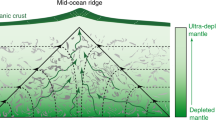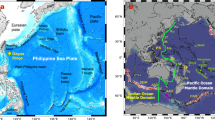Abstract
The Earth’s mantle is heterogeneous as a result of early planetary differentiation and subsequent crustal recycling during plate tectonics. Radiogenic isotope signatures of mid-ocean ridge basalts have been used for decades to map mantle composition, defining the depleted mantle endmember. These lavas, however, homogenize via magma mixing and may not capture the full chemical variability of their mantle source. Here, we show that the depleted mantle is significantly more heterogeneous than previously inferred from the compositions of lavas at the surface, extending to highly enriched compositions. We perform high-spatial-resolution isotopic analyses on clinopyroxene and plagioclase from lower crustal gabbros drilled on a depleted ridge segment of the northern Mid-Atlantic Ridge. These primitive cumulate minerals record nearly the full heterogeneity observed along the northern Mid-Atlantic Ridge, including hotspots. Our results demonstrate that substantial mantle heterogeneity is concealed in the lower oceanic crust and that melts derived from distinct mantle components can be delivered to the lower crust on a centimetre scale. These findings provide a starting point for re-evaluation of models of plate recycling, mantle convection and melt transport in the mantle and the crust.
This is a preview of subscription content, access via your institution
Access options
Access Nature and 54 other Nature Portfolio journals
Get Nature+, our best-value online-access subscription
$29.99 / 30 days
cancel any time
Subscribe to this journal
Receive 12 print issues and online access
$259.00 per year
only $21.58 per issue
Buy this article
- Purchase on Springer Link
- Instant access to full article PDF
Prices may be subject to local taxes which are calculated during checkout





Similar content being viewed by others
Data availability
The data supporting the findings of this study are available within the Article and the Methods and in the PetDB data repository (http://www.earthchem.org/petdbWeb/search/readydata/MAR55S-52N_major_trace_isotope.csv).
Code availability
The code used to calculate adiabatic melting of a two-component mantle source, Melt-PX (ref. 52), can be accessed at https://doi.org/10.1002/2015JB012762.
References
Allègre, C. J. & Turcotte, D. L. Implications of a two-component marble-cake mantle. Nature 323, 123–127 (1986).
Hofmann, A. W. Mantle geochemistry: the message from oceanic volcanism. Nature 385, 219–229 (1997).
Hart, S. R. Heterogeneous mantle domains: signatures, genesis and mixing chronologies. Earth Planet. Sci. Lett. 90, 273–296 (1988).
White, W. M. Sources of oceanic basalts: radiogenic isotopic evidence. Geology 13, 115–118 (1985).
Cohen, R. S., Evensen, N. M., Hamilton, P. J. & O’Nions, R. K. U–Pb, Sm–Nd and Rb–Sr systematics of mid-ocean ridge basalt glasses. Nature 283, 149–153 (1980).
Batiza, R. Inverse relationship between Sr isotope diversity and rate of oceanic volcanism has implications for mantle heterogeneity. Nature 309, 440–441 (1984).
Cipriani, A., Brueckner, H. K., Bonatti, E. & Brunelli, D. Oceanic crust generated by elusive parents: Sr and Nd isotopes in basalt-peridotite pairs from the Mid-Atlantic Ridge. Geology 32, 657–660 (2004).
Stracke, A. et al. Abyssal peridotite Hf isotopes identify extreme mantle depletion. Earth Planet. Sci. Lett. 308, 359–368 (2011).
Warren, J. M. Global variations in abyssal peridotite compositions. Lithos 248, 193–219 (2016).
Salters, V. J. M. & Dick, H. J. B. Mineralogy of the mid-ocean-ridge basalt source from neodymium isotopic composition of abyssal peridotites. Nature 418, 68–72 (2002).
Warren, J. M., Shimizum, N., Sakaguchi, C., Dick, H. J. B. & Nakamura, E. An assessment of upper mantle heterogeneity based on abyssal peridotite isotopic compositions. J. Geophys. Res. Solid Earth 114, B12203 (2009).
Brunelli, D., Cipriani, A. & Bonatti, E. Thermal effects of pyroxenites on mantle melting below mid-ocean ridges. Nat. Geosci. 11, 520–525 (2018).
Mallick, S., Dick, H. J., Sachi-Kocher, A. & Salters, V. J. Isotope and trace element insights into heterogeneity of subridge mantle. Geochem. Geophys. Geosyst. 15, 2438–2453 (2014).
Snow, J. E., Hart, S. R. & Dick, H. J. B. Nd and Sr isotope evidence linking mid-ocean-ridge basalts and abyssal peridotites. Nature 371, 57–60 (1994).
Gale, A., Dalton, C. A., Langmuir, C. H., Su, Y. & Schilling, J. G. The mean composition of ocean ridge basalts. Geochem. Geophys. Geosyst. 14, 489–518 (2013).
Blackman, D. K. et al. Drilling constraints on lithospheric accretion and evolution at Atlantis Massif, Mid‐Atlantic Ridge 30°N. J. Geophys. Res. 116, B07103 (2011).
Leuthold, J. et al. Partial melting of lower oceanic crust gabbro: constraints from poikilitic clinopyroxene primocrysts. Front. Earth Sci. 6, 15 (2018).
Schleicher, J. M. & Bergantz, G. W. The mechanics and temporal evolution of an open-system magmatic intrusion into a crystal-rich magma. J. Petrol. 58, 1059–1072 (2017).
Lissenberg, C. J. & MacLeod, C. J. A reactive porous flow control on mid-ocean ridge magmatic evolution. J. Petrol. 57, 2195–2220 (2016).
Cherniak, D. J. REE diffusion in feldspar. Chem. Geol. 193, 25–41 (2003).
Van Orman, J. A., Grove, T. L. & Shimizu, N. Rare earth element diffusion in diopside: influence of temperature, pressure, and ionic radius, and an elastic model for diffusion in silicates. Contrib. Mineral. Petrol. 141, 687–703 (2001).
Lambart, S. No direct contribution of recycled crust in Icelandic basalts. Geochem. Perspect. Lett. 4, 7–12 (2017).
Shorttle, O. Geochemical variability in MORB controlled by concurrent mixing and crystallization. Earth Planet. Sci. Lett. 424, 1–14 (2015).
Hart, S., Blusztajn, J., Dick, H. J. B., Meyer, P. S. & Muehlenbachs, K. The fingerprint of seawater circulation in a 500-meter section of ocean crust gabbros. Geochim. Cosmochim. Acta 63, 4059–4080 (1999).
Barth, G. A. & Mutter, J. C. Variability in oceanic crustal thickness and structure: multichannel seismic reflection results from the northern East Pacific Rise. J. Geophys. Res. 101, 17951–17975 (1996).
Wang, T., Lin, J., Tucholke, B. & Chen, Y. J. Crustal thickness anomalies in the North Atlantic Ocean basin from gravity analysis. Geochem. Geophys. Geosyst. 12, Q0AE02 (2011).
Langmuir, C. H., Klein, E. M. & Plank, T. Petrological systematics of mid-ocean ridge basalts: constraints on melt generation beneath ocean ridges. Geophys. Monogr. Ser. 71, 183–280 (1992).
Maclennan, J. Concurrent mixing and cooling of melts under Iceland. J. Petrol. 49, 1931–1953 (2008).
Wang, T., Tucholke, B. E. & Lin, J. Spatial and temporal variations in crustal production at the Mid-Atlantic Ridge, 5°N–27°30′N and 0–27 Ma. J. Geophys. Res. Solid Earth 120, 2119–2142 (2015).
Kogiso, T., Hirschmann, M. M. & Reiners, P. W. Length scales of mantle heterogeneities and their relationship to ocean island basalt geochemistry. Geochim. Cosmochim. Acta 68, 345–360 (2004).
Liu, B. & Liang, Y. The prevalence of kilometer-scale heterogeneity in the source region of MORB upper mantle. Sci. Adv. 3, e1701872 (2017).
Kelemen, P. B., Shimizu, N. & Salters, V. J. M. Extraction of mid-ocean-ridge basalt from the upwelling mantle by focused flow of melt in dunite channels. Nature 375, 747–753 (1995).
Spiegelman, M., Kelemen, P. B. & Aharonov, E. Causes and consequences of flow organization during melt transport: the reaction infiltration instability in compactible media. J. Geophys. Res. 106, 2061–2077 (2001).
Elliott, T. & Spiegelman, M. in Treatise on Geochemistry 2nd edn (eds Holland, H. D. & Turekian, K. K.). 543–581 (Elsevier, 2014).
Lambart, S., Laporte, D., Provost, A. & Schiano, P. Fate of pyroxenite-derived melts in the peridotitic mantle: thermodynamical and experimental constraints. J. Petrol. 53, 451–476 (2012).
Yaxley, G. & Green, D. H. Reactions between eclogite and peridotite: mantle refertilisation by subduction of oceanic crust. Schweiz. Mineral. Petrogr. Mitt. 78, 243–255 (1998).
Weatherley, S. M. & Katz, R. F. Melting and channelized magmatic flow in chemically heterogeneous, upwelling mantle. Geochem. Geophys. Geosyst. 13, Q0AC18 (2012).
Weatherley, S. M. & Katz, R. F. Melt transport rates in heterogeneous mantle beneath mid-ocean ridges. Geochim Cosmochim. Acta 172, 39–54 (2016).
Anderson, D. L. The scales of mantle convection. Tectonophysics 284, 1–17 (1998).
Stixrude, L. & Lithgow-Bertelloni, C. Geophysics of chemical heterogeneity in the mantle. Annu. Rev. Earth Planet. Sci. 40, 569–595 (2012).
Wanless, V. D. & Shaw, A. M. Lower crustal crystallization and melt evolution at mid-ocean ridges. Nat. Geosci. 5, 651–655 (2012).
Delacour, A., Früh-Green, G. L., Frank, M., Gutjahr, M. & Kelley, D. S. Sr- and Nd-isotope geochemistry of the Atlantis Massif (30°N, MAR): implications for fluid fluxes and lithospheric heterogeneity. Chem. Geol. 254, 19–35 (2008).
Lehnert, K., Su, Y., Langmuir, C., Sarbas, B. & Nohl, U. A global geochemical database structure for rocks. Geochem. Geophys. Geosyst. 1, 1012 (2000).
Charlier, B. L. A. et al. Methods for the microsampling and high-precision analysis of strontium and rubidium isotopes at single crystal scale for petrological and geochronological applications. Chem. Geol. 232, 114–133 (2006).
Koornneef, J. M. et al. TIMS analysis of Sr and Nd isotopes in melt inclusions from Italian potassium-rich lavas using prototype 1013 Ω amplifiers. Chem. Geol. 397, 14–23 (2015).
Millet, M. –A., Doucelance, R., Schiano, P., David, K. & Bosq, C. Mantle plume heterogeneity versus shallow-level interactions: a case study, the São Nicolau Island, Cape Verde archipelago. J. Volcanol. Geotherm. Res. 176, 265–276 (2008).
McGee, L. E., Smith, I. E., Millet, M.-A., Handley, H. K. & Lindsay, J. M. Asthenospheric control of melting processes in a monogenetic basaltic system: a case study of the Auckland Volcanic Field, New Zealand. J. Petrol. 54, 2125–2153 (2013).
McCoy-West, A. J., Millet, M.-A. & Burton, K. W. The neodymium stable isotope composition of the silicate Earth and chondrites. Earth Planet. Sci. Lett. 480, 121–132 (2017).
Koornneef, J. M., Bouman, C., Schwieters, J. B. & Davies, G. R. Use of 1012 ohm current amplifiers in Sr and Nd isotope analyses by TIMS for application to sub-nanogram samples. J. Anal. Spectrom. 28, 749–754 (2013).
Stracke, A., Bizimis, M. & Salters, V. J. M. Recycling oceanic crust: quantitative constraints. Geochem. Geophys. Geosyst. 4, 8003 (2003).
Workman, R. K. & Hart, S. R. Major and trace element composition of the depleted MORB mantle (DMM). Earth Planet. Sci. Lett. 231, 53–72 (2005).
Lambart, S., Baker, M. B. & Stolper, E. M. The role of pyroxenite in basalt genesis: Melt-PX, a melting parameterization for mantle pyroxenites between 0.9 and 5 GPa. J. Geophys. Res. Solid Earth 121, 5708–5735 (2016).
Smith, P. M. & Asimow, P. D. Adiabat_1ph: a new public front-end to the MELTS, pMELTS, and pHMELTS models. Geochem. Geophys. Geosyst. 6, Q02004 (2005).
Kogiso, T., Hirose, K. & Takahashi, E. Melting experiments on homogeneous mixtures of peridotite and basalt: application to the genesis of ocean island basalts. Earth Planet. Sci. Lett. 162, 45–61 (1998).
Hirschmann, M. M. & Stolper, E. M. A possible role for garnet pyroxenite in the origin of the “garnet signature” in MORB. Contrib. Mineral. Petrol. 124, 185–208 (1996).
Sobolev, A. V. et al. The amount of recycled crust in sources of mantle derived melts. Science 316, 590–597 (2007).
Acknowledgements
This work was supported by the European Union’s Horizon 2020 research and innovation programme (Marie Skłodowska-Curie grant agreement No. 663830) and National Science Foundation (EAR-1834367) to S.L. and by the award NERC NE/R001332/1 to M.-A.M. We thank D. Muir, I. McDonald, T. Oldroyd and M. Jansen for their assistance on the scanning electron microscope, with LA-ICP-MS, with sample preparation and in using the micromill, respectively.
Author information
Authors and Affiliations
Contributions
C.J.L. designed the study. S.L. and C.J.L. wrote the manuscript with input from M.-A.M., J.M.K. and G.R.D. S.L. and C.J.L. selected the samples. S.L. and M.C. performed the element maps. S.L. performed trace element analyses and geochemical modelling. S.L. and C.J.L. performed micromilling, and S.L., C.J.L., M.-A.M. and J.M.K. performed column chemistry and isotopic analyses.
Corresponding author
Ethics declarations
Competing interests
The authors declare no competing interests.
Additional information
Publisher’s note: Springer Nature remains neutral with regard to jurisdictional claims in published maps and institutional affiliations.
Supplementary information
Supplementary Information
Supplementary Figures 1–6 and Table 1
Rights and permissions
About this article
Cite this article
Lambart, S., Koornneef, J.M., Millet, MA. et al. Highly heterogeneous depleted mantle recorded in the lower oceanic crust. Nat. Geosci. 12, 482–486 (2019). https://doi.org/10.1038/s41561-019-0368-9
Received:
Accepted:
Published:
Issue Date:
DOI: https://doi.org/10.1038/s41561-019-0368-9
This article is cited by
-
Extreme isotopic heterogeneity in Samoan clinopyroxenes constrains sediment recycling
Nature Communications (2021)



